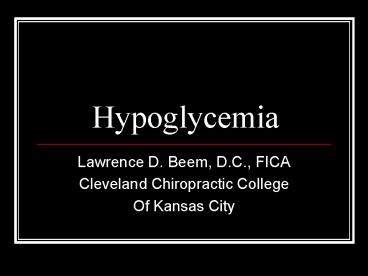Hypoglycemia - PowerPoint PPT Presentation
1 / 9
Title:
Hypoglycemia
Description:
Hypoglycemia as a medical problem is diagnosed by the presence of 3 key features, ... blurry or double vision. difficulty learning or remembering. Hypoglycemia ... – PowerPoint PPT presentation
Number of Views:3632
Avg rating:3.0/5.0
Title: Hypoglycemia
1
Hypoglycemia
- Lawrence D. Beem, D.C., FICA
- Cleveland Chiropractic College
- Of Kansas City
2
Hypoglycemia
- Hypoglycemia as a medical problem is diagnosed by
the presence of 3 key features, also known as the
Whipple triad. - The Whipple triad consists of the following (1)
symptoms consistent with hypoglycemia, (2) a low
plasma glucose concentration, and (3) relief of
symptoms after the plasma glucose level is
raised.
3
Hypoglycemia
- Hyperactivity is extremely common, however, in
children with learning difficulties and having
even one child like this at home or in the
classroom can activate latent behavior problems
in the parents and teachers.
4
Hypoglycemia
- The most frequently cited characteristics of this
disorder in order of decreasing frequency are - hypoadrenia
- hyperactivity,
- perceptual-motor impairments,
- emotional liability,
- general orientation defects,
- disorders of attention (e.g., short attention
span, distractibility), - impulsivity,
- disorders of memory and thinking,
- specific disabilities in reading, arithmetic,
writing, and spelling, - disorders of speech and hearing, and
- equivocal classic neurological signs and
electroencephalogram (EEG) irregularities. - These are symptoms of a disorder that probably
affects more children than anything save the
common cold.
5
Hypoglycemia
- Diagnostic Procedures
- In addition to the five-hour glucose-tolerance
test and hair and blood analysis for trace
mineral ratios, the following evaluations are
implemented - 1. Detailed medical, family, and social history
- 2. General physical examination, neurological
exam, and chiropractic exam (most of these
children have chiropractic, i.e.,
musculo-skeletal problems), including cranial. - 3. Functional neurological evaluation
- 4. Audiology, if indicated
- 5. Developmental visual analysis
- 6. Complete blood count and urinalysis
- 7. Comprehensive blood profile
- 8. Tests for food sensitivity and chemical and
inhalant sensitivity, if indicated - 9. Comprehensive stool exam
- 10. Test for Candida (yeast)
- Glucose Tolerance Test Procedure
6
Hypoglycemia
- What are the symptoms of hypoglycemia?
- The following are the most common symptoms for
hypoglycemia. However, each child may experience
symptoms differently. Symptoms may include - shakiness
- dizziness
- sweating
- hunger
- headache
- irritability
- pale skin color
- sudden moodiness or behavior changes, such as
crying for no apparent reason - clumsy or jerky movements
- difficulty paying attention, or confusion
- tingling sensations around the mouth
- rapid heart rate
- blurry or double vision
- difficulty learning or remembering
7
Hypoglycemia
- Treatment for hypoglycemia
- avoiding foods high in carbohydrates
- eating smaller meals more frequently
- frequent snacks
- eating a variety of healthy foods
- regular exercise
- Avoiding foods with dyes or transfats
- Avoiding nitrates or nitrites
8
Hypoglycemia
- A condition often linked to hypoglycemia is
hypoadrenia. - Is brought on by the 8 stressors of the body
- Trauma
- Emotional trauma
- Nutritional stress
- Chemical stress
- Exposure to sun
- Exposure to cold
- Exposure to heat
- Fatigue
9
Other Books To Read
- The Stress of Life- Hans Selye
- Sugar Blues- William Duffy































